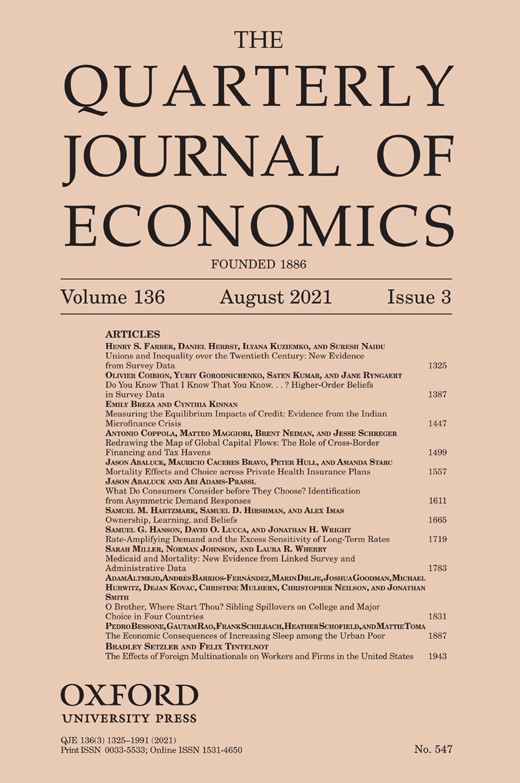Entrepreneurship, Innovation und Produktivitätswachstum
Diese Gruppe befasst sich mit Forschungsthemen, die für unser Verständnis von Innovationsmustern und Produktivitätswachstum von Bedeutung sind, und untersucht die Auswirkungen auf Arbeitnehmer und Unternehmen. Zu den Schwerpunkten gehören der Rückgang der Unternehmensdynamik, die Zunahme der Automatisierung, Entrepreneurship und Innovation sowie Lieferketten.
Forschungscluster
Produktivität und InstitutionenIhr Kontakt

- Abteilung Zentrum für Firmen- und Produktivitätsdynamik
Referierte Publikationen

The (Heterogeneous) Economic Effects of Private Equity Buyouts
in: Management Science, im Erscheinen
Abstract
<p>The effects of private equity buyouts on employment, productivity, and job reallocation vary tremendously with macroeconomic and credit conditions, across private equity groups, and by type of buyout. We reach this conclusion by examining the most extensive database of U.S. buyouts ever compiled, encompassing thousands of buyout targets from 1980 to 2013 and millions of control firms. Employment shrinks 12% over two years after buyouts of publicly listed firms—on average, and relative to control firms—but expands 15% after buyouts of privately held firms. Postbuyout productivity gains at target firms are large on average and much larger yet for deals executed amid tight credit conditions. A postbuyout tightening of credit conditions or slowing of gross domestic product growth curtails employment growth and intrafirm job reallocation at target firms. We also show that buyout effects differ across the private equity groups that sponsor buyouts, and these differences persist over time at the group level. Rapid upscaling in deal flow at the group level brings lower employment growth at target firms. We relate these findings to theories of private equity that highlight agency problems at portfolio firms and within the private equity industry itself.</p>

Robot Hubs and the Use of Robotics in US Manufacturing Establishments
in: American Economic Association Papers and Proceedings, May 2025
Abstract
<p>We use data from the Annual Survey of Manufactures to study the characteristics and geographic distribution of investments in robots across US manufacturing establishments. Robotics adoption and robot intensity (the number of robots per employee) cluster in "robot hubs." Establishments that report having robotics are larger and have a larger production worker share, lower pay per worker, lower labor share, and higher capital expenditures, including higher IT capital expenditures. Notably, establishments are more likely to have robots if other establishments in the same core-based statistical area and industry also report having robotics, suggestive of agglomeration and peer effects.</p>

Reservation Raises: The Aggregate Labour Supply Curve at the Extensive Margin
in: Review of Economic Studies, Nr. 1, 2025
Abstract
<p>We measure desired labour supply at the extensive (employment) margin in two representative surveys of the U.S. and German populations. We elicit reservation raises: the percent wage change that renders a given individual indifferent between employment and nonemployment. It is equal to her reservation wage divided by her actual, or potential, wage. The reservation raise distribution is the nonparametric aggregate labour supply curve. Locally, the curve exhibits large short-run elasticities above 3, consistent with business cycle evidence. For larger upward shifts, arc elasticities shrink towards 0.5, consistent with quasi-experimental evidence from tax holidays. Existing models fail to match this nonconstant, asymmetric curve.</p>

Productivity, Place, and Plants
in: Review of Economics and Statistics, Nr. 5, 2024
Abstract
<p>Why do cities differ so much in productivity? A long literature has sought out systematic sources, such as inherent productivity advantages, market access, agglomeration forces, or sorting. We document that up to three quarters of the measured regional productivity dispersion is spurious, reflecting the “luck of the draw” of finite counts of idiosyncratically heterogeneous plants that happen to operate in a given location. The patterns are even more pronounced for new plants, hold for alternative productivity measures, and broadly extend to European countries. This large role for individual plants suggests a smaller role for places in driving regional differences.</p>

Worker Beliefs about Outside Options
in: Quarterly Journal of Economics, Nr. 3, 2024
Abstract
<p>Standard labor market models assume that workers hold accurate beliefs about the external wage distribution, and hence their outside options with other employers. We test this assumption by comparing German workers’ beliefs about outside options with objective benchmarks. First, we find that workers wrongly anchor their beliefs about outside options on their current wage: workers that would experience a 10% wage change if switching to their outside option only expect a 1% change. Second, workers in low-paying firms underestimate wages elsewhere. Third, in response to information about the wages of similar workers, respondents correct their beliefs about their outside options and change their job search and wage negotiation intentions. Finally, we analyze the consequences of anchoring in a simple equilibrium model. In the model, anchored beliefs keep overly pessimistic workers stuck in low-wage jobs, which gives rise to monopsony power and labor market segmentation.</p>
Arbeitspapiere

Credit Card Entrepreneurs
in: IWH Discussion Papers, Nr. 5, 2025
Abstract
<p>Utilizing near real-time QuickBooks data from over 1.6 million small businesses and a targeted survey, this paper highlights the critical role credit card financing plays for small business activity. We examine a two year period beginning in January of 2021. A turbulent period during which, credit card usage by small U.S. businesses nearly doubled, interest payments rose by 60%, and delinquencies reached 2.8%. We find, first, monthly credit card payments were up to three times higher than loan payments during this time. Second, we use targeted surveys of these small businesses to establish credit cards as a key financing source in response to firm-level shocks, such as uncertain cash flows and overdue invoices. Third, we establish the importance of credit cards as an important financial transmission mechanism. Following the Federal Reserve’s rate hikes in early 2022, banks cut credit card supply, leading to a 15.75% drop in balances and a 10% decline in revenue growth, as well as a 1.5% decrease in employment growth among U.S. small businesses. These higher rates also rendered interest payments unsustainable for many, contributing to half of the observed increase in delinquencies. Lastly, a simple heterogeneous firm model with a cash-in-hand constraint illustrates the significant macroeconomic impact of credit card financing on small business activity.</p>

Reassessing EU Comparative Advantage: The Role of Technology
in: IWH Discussion Papers, Nr. 26, 2024
Abstract
<p>Based on the sufficient statistics approach developed by Huang and Ottaviano (2024), we show how the state of technology of European industries relative to the rest of the world can be empirically assessed in a way that is simple in terms of computation, parsimonious in terms of data requirements, but still comprehensive in terms of information. The lack of systematic cross-industry correlation between export specialization and technological advantage suggests that standard measures of revealed comparative advantage only imperfectly capture a country’s technological prowess due to the concurrent influences of factor prices, market size, markups, firm selection and market share reallocation.</p>

From Labor to Intermediates: Firm Growth, Input Substitution, and Monopsony
in: IWH Discussion Papers, Nr. 24, 2024
Abstract
<p>We document and dissect a new stylized fact about firm growth: the shift from labor to intermediate inputs. This shift occurs in input quantities, cost and output shares, and output elasticities. We establish this fact using German firm-level data and replicate it in administrative firm data from 11 additional countries. We also document these patterns in micro-aggregated industry data for 20 European countries (and, with respect to industry cost shares, for the US). We rationalize this novel regularity within a parsimonious model featuring (i) an elasticity of substitution between intermediates and labor that exceeds unity, and (ii) an increasing shadow price of labor relative to intermediates, due to monopsony power over labor or labor adjustment costs. The shift from labor to intermediates accounts for one half to one third of the decline in the labor share in growing firms (the remainder is due to wage markdowns and markups) and rationalizes most of the labor share decline in growing industries.</p>

Declining Job Reallocation in Europe: The Role of Shocks, Market Power, and Technology
in: IWH Discussion Papers, Nr. 19, 2023
Abstract
<p>We study changes in job reallocation in Europe after 2000 using novel microaggregated data that we collected for 19 European countries. In all countries, we document broad-based declines in job reallocation rates that concern most economic sectors and size classes. These declines are mainly driven by dynamics within sectors, size, and age classes rather than by compositional changes. Simultaneously, employment shares of young firms decline. Consistent with US evidence, firms’ employment has become less responsive to productivity shocks. However, the dispersion of firms’ productivity shocks has decreased too. To enhance our understanding of these patterns, we derive and apply a firm-level framework that relates changes in firms’ market power, labor market imperfections, and production technology to firms’ responsiveness and job reallocation. Using German firm-level data, we find that changes in markups and labor output elasticities, rather than adjustment costs, are key in rationalizing declining responsiveness.</p>

Intuit QuickBooks Small Business Index: A New Employment Series for the US, Canada, and the UK
in: IWH Discussion Papers, Nr. 9, 2023
Abstract
Small and young businesses are essential for job creation, innovation, and economic growth. Even most of the superstar firms start their business life small and then grow over time. Small firms have less internal resources, which makes them more fragile and sensitive to macroeconomic conditions. This suggests the need for frequent and real-time monitoring of the small business sector’s health. Previously this was difficult due to a lack of appropriate data. This paper fills this important gap by developing a new Intuit QuickBooks Small Business Index that focuses on the smallest of small businesses with at most 9 workers in the US and the UK and at most 19 workers in Canada. The Index aggregates a sample of anonymous Quick- Books Online Payroll subscriber data (QBO Payroll sample) from 333,000 businesses in the US, 66,000 in Canada, and 25,000 in the UK. After comparing the QBO Payroll sample data to the official statistics, we remove the seasonal components and use a Flexible Least Squares method to calibrate the QBO Payroll sample data against official statistics. Finally, we use the estimated model and the QBO Payroll sample data to generate a near real-time index of economic activity. We show that the estimated model performs well both in-sample and out-of-sample. Additionally, we use this analysis for different regions and industries. Keywords:














